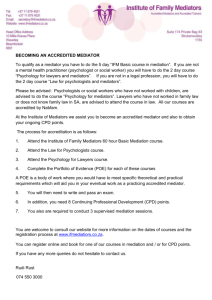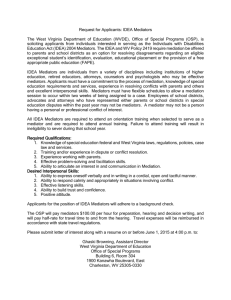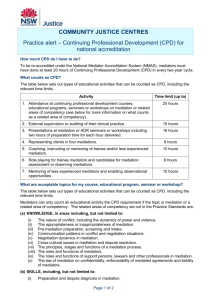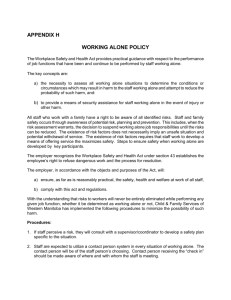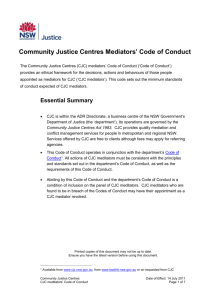mandatory reporting - Community Justice Centres
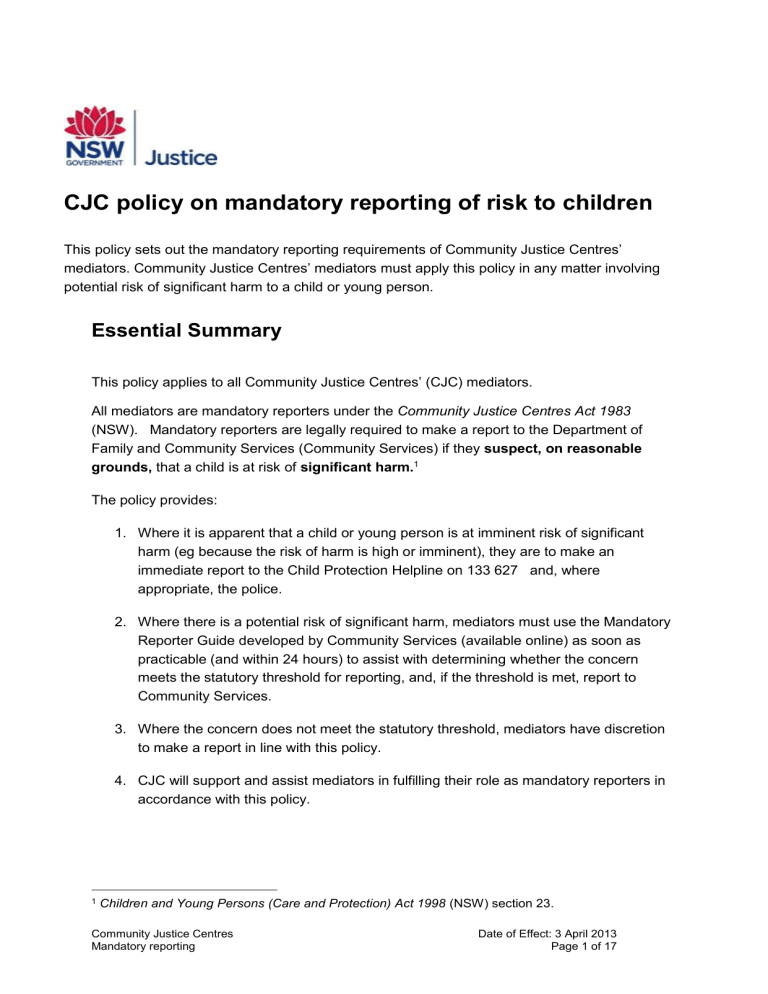
CJC policy on mandatory reporting of risk to children
This policy sets out the mandatory reporting requirements of Community Justice Centres’ mediators. Community Justice Centres’ mediators must apply this policy in any matter involving potential risk of significant harm to a child or young person.
Essential Summary
This policy applies to all Community Justice Centres’ (CJC) mediators.
All mediators are mandatory reporters under the Community Justice Centres Act 1983
(NSW). Mandatory reporters are legally required to make a report to the Department of
Family and Community Services (Community Services) if they suspect, on reasonable grounds, that a child is at risk of significant harm.
1
The policy provides:
1. Where it is apparent that a child or young person is at imminent risk of significant harm (eg because the risk of harm is high or imminent), they are to make an immediate report to the Child Protection Helpline on 133 627 and, where appropriate, the police.
2. Where there is a potential risk of significant harm, mediators must use the Mandatory
Reporter Guide developed by Community Services (available online) as soon as practicable (and within 24 hours) to assist with determining whether the concern meets the statutory threshold for reporting, and, if the threshold is met, report to
Community Services.
3. Where the concern does not meet the statutory threshold, mediators have discretion to make a report in line with this policy.
4. CJC will support and assist mediators in fulfilling their role as mandatory reporters in accordance with this policy.
1 Children and Young Persons (Care and Protection) Act 1998 (NSW) section 23.
Community Justice Centres
Mandatory reporting
Date of Effect: 3 April 2013
Page 1 of 17
5. Where a mediation raises issues related to risk to a child, and a mediator has considered and decided for or against making a mandatory or discretionary report, mediators must provide the information required in the standard feedback and debriefing form completed at the end of each mediation.
Printed copies of this document may not be up to date.
Ensure you have the latest version before using this document.
Community Justice Centres
Mandatory reporting
Date of Effect: 3 April 2013
Page 2 of 17
Table of contents
Table of contents
1 Scope
2 Purpose
3 Definitions
4 Dut y to report child “at risk of significant harm”
5 Safeguards for mediators making a report
6 When report is mandatory
7 Terminating or adjourning mediation due to risk
8 Referrals
9 Non-mandatory disclosure
9
9
10 Mediator to inform CJC when issues relating to risk and reporting arise 10
11 Responding to disclosures
12 References
13 Annexure A
– relevant legislation
14 Annexure B – process summary
6
9
11
13
14
15
15 Document information
16 Document history
17
17
4
5
6
3
4
4
Community Justice Centres
Mandatory reporting
Date of Effect: 3 April 2013
Page 3 of 17
1 Scope
This policy must be applied by mediators when dealing with matters in which there is a potential risk of significant harm to a child or young person. The policy applies to mediations in which:
one or more of the parties is a child or young person, and
all parties are adults and information is disclosed suggesting there is a potential risk of significant harm to a child or young person.
2 Purpose
The purpose of this policy is to ensure that:
1. Mediators are aware of their mandatory reporting obligations under the Community
Justice Centres Act 1983 (NSW) and the Children and Young Persons (Care and
Protection) Act 1998 (NSW).
2. Mediators are equipped to make decisions about reporting or disclosing any concerns that they may have about risk of harm to a child or young person.
3. Mediators share adequate information about any concerns of risk of harm to a child or young person, and any reports made, with CJC.
4. The services provided by CJC promote the safety, welfare and wellbeing of children and young people.
This policy covers all mediations undertaken by CJC, including mediations to which a child or young person is a party, and mediations between adults in which information about risk of harm to a child or young person may be disclosed.
3 Definitions
Child means anyone under the age of 16 years.
2
Young person means anyone aged 16 or 17 years.
3
2 Children and Young Persons (Care and Protection) Act 1998 (NSW) section 3.
3 Ibid.
Community Justice Centres
Mandatory reporting
Date of Effect: 3 April 2013
Page 4 of 17
Mandatory Reporter Guide (MRG) is a tool produced by the Community Services to assist mandatory reporters with determining whether the concern meets the statutory threshold for reporting. The MRG includes an online decision tree tool and its written equivalent.
Mandatory reporters are those who deliver certain services to children as part of their paid or professional work. Mandatory reporters must report risk of significant harm to a child to the
NSW Department of Family and Community Services (Community Services).
4 Mediators are mandatory reporters in the course of their work with CJC.
Mediation is a process in which the disputants, with the assistance of a mediator, identify the disputed issues, develop options, consider alternatives and endeavour to reach an agreement. The mediator has no advisory or determinative role in regard to the content of the dispute or the outcome of the mediation. CJC mediation involving children or young persons will generally be conducted by two mediators using a co-mediation model.
Pre-mediation is a process conducted with a party in private before mediation in order to:
Assess the suitability of the dispute for mediation.
Explain the mediation process and prepare the party for mediation.
Provide the party with appropriate referrals if necessary.
4
Duty to report child “at risk of significant harm”
Mediators are ‘mandatory reporters’ under section 29A of the Community Justice Centres Act
1983 (NSW).
Mandatory reporters are required by law to report to the Community Services if they suspect, on reasonable grounds, that a child is at risk of significant harm.
5
Mandatory reporters are not legally required to report risk of significant harm to unborn children or young people (those aged 16-17 years) but may do so where appropriate and in accordance with CJC policy and the Community Justice Centres Act 1983 (NSW).
Although the legal responsibility for making a mandatory report rests with mediators personally, CJC is able to provide assistance and support to mediators when dealing with disclosures of risk. Mediators are welcome to contact CJC at any time to discuss any matters that arise and get assistance in assessing whether or not the situation meets the mandatory reporting threshold.
More information about how to decide whether a situation amounts to “risk of significant harm” and must therefore be reported is set out below.
4 Children and Young Persons (Care and Protection) Act 1998 (NSW) section 27.
5 Children and Young Persons (Care and Protection) Act 1998 (NSW) section 23.
Community Justice Centres
Mandatory reporting
Date of Effect: 3 April 2013
Page 5 of 17
5 Safeguards for mediators making a report
Reports to Community Services a re confidential and the reporter’s identity (if known) is protected by law if the report is made in good faith. The law offers the following protections:
The report shall not be held to be a breach of professional etiquette or ethics or a departure from accepted standards of professional conduct.
No liability for defamation can be incurred because of the making of the report.
The report, or its contents, is not admissible in any proceedings as evidence against the person who made the report.
A person cannot be compelled by a court to provide the report or give any evidence as to its contents.
If law enforcement agencies require the identity of a reporter in order to investigate serious offences alleged to have been committed against children or young people, the identity of the reporter may be released to the police. The reporter will be notified that their identity is to be released to the police unless doing this would prejudice the investigation.
6 When report is mandatory
6.1
Meaning of “at risk of significant harm”
The statutory threshold for mandatory reporting is “at risk of significant harm”. This means current rather than historical risk.
Significant means the issue is not minor or trivial. The risk can be as a result of a single act or omission or as a result of an accumulation of these.
All mediators should be familiar with the reporting requirements so that they are prepared to respond appropriately to any disclosure made.
In brief, a child or young person is considered to be at risk of “significant harm” if:
T he child or young person’s basic physical or psychological needs are not being met.
The parents or carers have not arranged, and are unable or unwilling to arrange, for the child or young person to receive necessary medical care.
The parents or other carers have not arranged, and are unable or unwilling to arrange, for the child or young person to receive an education , and the child is required to attend school.
Community Justice Centres
Mandatory reporting
Date of Effect: 3 April 2013
Page 6 of 17
The child or young person has been, or is at risk of being, physically or sexually abused or ill-treated.
The child or young person is living in a house where there have been incidents of domestic violence , and as a consequence, the child or young person is at risk of serious physical or psychological harm .
A parent or other carer has behaved towards the child or young person in such a way that they are at risk of suffering serious psychological harm .
A full list of the considerations in determining whether a child is at risk of significant harm, as found in section 23 of the Children and Young Persons (Care and Protection) Act 1998
(NSW), is included at Annexure A to this policy.
6.2 Where the risk of significant harm is obvious because it is high or imminent
In some cases, it will be reasonably clear that there is a significant risk of harm to a child because that risk is serious or imminent, for example where there is:
Serious physical injury to a child or young person requiring medical attention.
Serious neglect to a child or young person of an immediate nature.
Domestic violence involving serious injury and/or use of a weapon.
Sexual harm involving serious current concerns.
Immediate safety issues.
Where the reporting threshold is clearly met because there is a high or imminent risk of harm, mediators should make an immediate report to the Child Protection Helpline on 133
627.
In an emergency, where there are urgent concerns for the child’s health or life, mediators should contact the police immediately on 000 before making the mandatory report.
6.3 Using the Mandatory Reporter Guide to establi sh whether the “risk of significant harm” threshold is met
In some cases of potential risk to a child, it is not obvious whether the situation meets the statutory reporting threshold of “risk of significant harm”. In such cases, mediators must use the Mandatory Reporter Guide (MRG) , produced by Community Services. Mediators may also contact CJC at any time to discuss any matters related to mandatory reporting and use of the MRG.
Community Justice Centres
Mandatory reporting
Date of Effect: 3 April 2013
Page 7 of 17
The MRG is an online decision tree tool. A written equivalent is also available. The decision tree tool is designed to guide mandatory reporters’ decision-making process by presenting a series of questions and, based on the answers given, generating a recommendation as to whether or not a report should be made. The MRG is a guide only, and ultimately mediators should rely on their own judgement with respect to whether or not the reporting threshold has been met.
A hard copy of the MRG is not annexed to this policy because the MRG is frequently updated. Mediators should access the MRG electronically as needed at http://www.keepthemsafe.nsw.gov.au/reporting_concerns/mandatory_reporter_guide .
If mediators do need to work from a hard copy for any reason, they must ensure they are using the current version. CJC can assist mediators to access and use electronic and hard copies of the MRG as required.
Mediators should use the MRG to assess whether a matter is reportable as soon as possible and at most within 24 hours of the disclosure.
Where the report generated by the MRG indicates the matter should be reported to
Community Services, mediators should make the report immediately by calling the Child
Protection Helpline on 133 627.
When using the MRG, mediators should note that, unlike some mandatory reporters, CJC mediators do not have access to a Child Wellbeing Unit. Instead, they should contact CJC management with any concerns.
6.4 Agreement or disagreement between co-mediators as to whether the “risk of significant harm” threshold is met
Mediators should discuss any decision about mandatory reporting together and where possible come to a joint decision.
Where both mediators agree that the situation meets the statutory reporting threshold of “risk of significant harm”, one mediator should make the report to Community Services on behalf of both mediators.
The legal obligation to make a mandatory report is an individual one. It is therefore not necessary for both mediators to agree in order to make a report. Where mediators are unable to reach a consensual decision as to whether the threshold is met, a mediator who feels the threshold has been met should make a report to Community Services on their own behalf.
Mediators are encouraged to contact CJC management staff (eg the practice manager or the director) if assistance is required in making this decision.
Community Justice Centres
Mandatory reporting
Date of Effect: 3 April 2013
Page 8 of 17
7 Terminating or adjourning mediation due to risk
Whether or not a mediation session needs to be terminated or adjourned because of a disclosure of risk of harm to a child is a matter to be decided by the mediator/s. An adjournment may range from a few minutes or hours, for mediators to make enquiries, telephone calls or to use the MRG, to a number of weeks or months if necessary.
It may be necessary to terminate or adjourn a mediation session because of potential risk to a child for reasons including:
It is impracticable to continue with the mediation because urgent steps are required to secure the child’s safety and make a report to Community Services.
It is inappropriate to continue with the mediation because the child protection issue must be resolved before it is possible to meaningfully discuss the subject matter of the mediation, eg where the subject of the dispute is whether the child should spend time with a parent who is accused of abuse.
8 Referrals
Regardless of whether or not a report is made to Community Services, mediators may arrange with the practice manager or team leader for referrals to be given.
9 Non-mandatory disclosure
If it appears (e.g. based on the report generated by the MRG) that the issue does not meet the mandatory reporting threshold, there is no legal duty to report the matter.
However, if a mediator still has concerns for the welfare of the child or young person they may consider making a non-mandatory, discretionary report.
Section 29(1)(c) of the Community Justice Centres Act 1983 (NSW) permits mediators to disclose information that would otherwise be subject to the secrecy provisions “where there are reasonable grounds to believe that disclosure is necessary to prevent or minimise the danger of injury to any person or damage to any property”.
6
This means that in these circumstances mediators have discretion to report or disclose information despite the secrecy provisions in the Community Justice Centres Act 1983
(NSW), even where the risk to a child does not meet the mandatory reporting threshold of risk of significant harm.
6 Ibid section 29(2)(c).
Community Justice Centres
Mandatory reporting
Date of Effect: 3 April 2013
Page 9 of 17
The obligation to maintain the confidentiality of mediation is a fundamental principle of mediation practice with CJC. The decision to make a non-mandatory disclosure is therefore a serious matter. Nevertheless it may be necessary and appropriate in some circumstances to make a discretionary report.
When considering whether or not to make a non-mandatory disclosure in accordance with section 29(1)(c) of the Community Justice Centres Act 1983 (NSW) , mediators are encouraged to use the MRG to assist with clarifying their concerns, and discuss possible actions with their co-mediator and CJC management staff.
10 Mediator to inform CJC when issues relating to risk and reporting arise
Providing details to CJC staff (whether verbal or written) regarding the mediator’s concern that a child is at risk of significant harm, the incidents that led to this concern, and the action that has been taken as a result, falls outside the secrecy provisions of the Community Justice
Centres Act 1983 (NSW) 7 and outside the mediator’s oath.
8,9 This means mediators will not breach their oath or the Act in disclosing information about risk of harm to a child to CJC.
Mediators should contact CJC if they would like guidance or assistance with a particular matter that raises mandatory reporting issues.
Where an issue arose during mediation regarding potential risk of significant harm to a child, mediators must complete question 4.5 on the feedback and debriefing form, which asks for the following details:
What disclosure led to the potential risk of significant harm to a child being identified.
A copy of the decision tree report generated by the MRG completed when deciding whether or not a report was to be made, or, if the MRG was not completed, an explanation of why (for example: a report was made before completing the MRG because there was a high or imminent risk of significant harm).
Whether a mandatory report was made and, if so, what was reported.
Whether a non-mandatory or discretionary report was made to Community Services or any other organisation and, if so, what was reported.
7 Community Justice Centres Act NSW (1983) section 29.
8 Ibid.
9 Community Justice Centres Act NSW (1983) section 29(2)(c1).
Community Justice Centres
Mandatory reporting
Date of Effect: 3 April 2013
Page 10 of 17
Where action has been taken after the feedback and debriefing form has been completed
(for example using the MRG) mediators are to provide the information that would otherwise be in the feedback and debriefing form in writing (eg by email) to CJC staff as soon as possible.
11 Responding to disclosures
It is important that mediators respond appropriately to parties who disclose anything that indicates that a child or young person is, or may be, at risk of harm.
It is not the role of mediators to open up discussion with parties about the abuse and neglect of children or young people, or to investigate concerns that children or young people are being harmed.
10
Immediately after hearing the disclosure, write down and date the comments and statement made by the person using their exact words. It is also important to record any observations about their mood or demeanour and communicate this information to the Helpline if you make a report.
Please refer to the CJC policy on mediating with children and young people for suggestions on how to respond to a disclosure by a child or young person that they, or another child or young person, is, or may be, at risk of harm.
With respect to disclosures made by adults, 11 a parent or carer may disclose they have or could harm their child, or that another household member has done so.
The behaviour of parents who harm or neglect their children, or fail to prevent harm to their children from others, may be due to a range of factors such as:
Lacking a successful model of parenting and family life.
Having been abused as children.
La cking an understanding of their child’s needs or of age-appropriate expectations.
Being overwhelmed by external stressors and unable to cope.
Expecting their child to satisfy their own emotional needs.
Being victims of violence themselves.
10 Australian Government and Family Relationship Advice Line (July 2008) Framework for Screening,
Assessment and Referrals in Family Relationship Centres and the Family Relationship Advice Line .
11 Information taken from http://www.community.nsw.gov.au/kts/guidelines/reporting/practice_guidance.htm
Community Justice Centres
Mandatory reporting
Date of Effect: 3 April 2013
Page 11 of 17
Not being able to control their anger or frustration, resulting in lashing out at their child.
Chronic illness, such as depression, or disability, which limits their ability to meet the needs of their children.
Mediators must suspend personal judgment about the parent and not either minimise or exaggerate their behaviour or attitudes. Mediators should focus on how the child is experiencing the parental or carer behaviours, their particular vulnerabilities and any risk of significant harm. The obligation to report current concerns exists regardless of a parent’s remorse or their stated intention to seek help.
11.1 Informing a parent or carer about a potential report
Mediators should exercise their professional judgement when deciding what information they wish to provide about any report to a parent or carer of the child. Mediators are able to discuss this decision with a co-mediator or CJC staff.
It is generally good practice for mediators to discuss concerns with the parent or carer if a report is to be made. Mediators will have noted the confidentiality of mediation and its exceptions at the beginning of mediation. Where a decision is made to inform the parent or carer of a child that a report is to be made, mediators should refer back to this information and explain that a disclosure of risk is one of the exceptions to the secrecy provisions and that you are required by law (or, if the report is non-mandatory, you are permitted) to make the report for the protection of the child.
However, there may be circumstances where it may not appropriate for the mediator to inform the parent/carer that the matter has been or is going to be reported, for example, the:
Urgency of the situation.
Perceived risk to the safety of the child or another person including the mediator.
De cision to report the matter was made after the mediator’s contact with the parent or carer had ceased, i.e. after the mediation session had finished or been terminated.
11.2 Informing a child or young person about a potential report
Where a child or young person has made a disclosure and a mediator decides to make a report to Community Services, a child or young person should be told that a report is being made to Community Services, where appropriate.
Mediators are able to discuss this decision with a co-mediator or CJC staff.
Factors to consider when determining whether to inform a child or young person that a report will be or has been made include:
Whether the abuse was disclosed intentionally or accidentally.
Community Justice Centres
Mandatory reporting
Date of Effect: 3 April 2013
Page 12 of 17
T he child’s age.
T he child’s capacity to understand the potential risk of harm to them and the reporting process.
It is not a legislative requirement to seek the consent of the child or young person when making a report except when reporting the homelessness of young people.
Mediators must still make a report where they believe that a child or young person is at risk of significant harm even if the child or young person opposes the mediator making a report.
When making a report, mediators should provide information about the child or young person’s reaction to hearing that a report is being made to Community Services, where the child or young person has been informed of this.
12
12 References
Australian Government and Family Relationship Advice Line (July 2008) Framework for
Screening, Assessment and Referrals in Family Relationship Centres and the Family
Relationship Advice Line
Children and Young Persons (Care and Protection) Act 1998 (NSW)
Community Justice Centres Act 1983 (NSW)
(End)
12 Ibid.
Community Justice Centres
Mandatory reporting
Date of Effect: 3 April 2013
Page 13 of 17
13 Annexure A – relevant legislation
Children and Young Persons (Care and Protection) Act 1998 (NSW)
Section 23 - child or young person at risk of significant harm
(1) For the purposes of this Part and Part 3, a child or young person is "at risk of significant harm" if current concerns exist for the safety, welfare or well-being of the child or young person because of the presence, to a significant extent, of any one or more of the following circumstances:
(a) the child’s or young person’s basic physical or psychological needs are not being met or are at risk of not being met,
(b) the parents or other caregivers have not arranged and are unable or unwilling to arrange for the child or young person to receive necessary medical care,
(b1) in the case of a child or young person who is required to attend school in accordance with the Education Act 1990 -the parents or other caregivers have not arranged and are unable or unwilling to arrange for the child or young person to receive an education in accordance with that Act,
(c) the child or young person has been, or is at risk of being, physically or sexually abused or ill-treated,
(d) the child or young person is living in a household where there have been incidents of domestic violence and, as a consequence, the child or young person is at risk of serious physical or psychological harm,
(e) a parent or other caregiver has behaved in such a way towards the child or young person that the child or young person has suffered or is at risk of suffering serious psychological harm,
(f) the child was the subject of a pre-natal report under section 25 and the birth mother of the child did not engage successfully with support services to eliminate, or minimise to the lowest level reasonably practical, the risk factors that gave rise to the report.
Note: Physical or sexual abuse may include an assault and can exist despite the fact that consent has been given.
(2) Any such circumstances may relate to a single act or omission or to a series of acts or omissions.
Community Justice Centres
Mandatory reporting
Date of Effect: 3 April 2013
Page 14 of 17
14 Annexure B – process summary
CJC mediator has concerns that a child or young person may be at risk of harm.
A. Mediator concerned there is high and/or imminent risk of significant harm to the child or young person.
1. If necessary, CJC mediator notifies emergency services or provides other referrals as required.
2. CJC mediator makes an immediate mandatory report to Child Protection Helpline on
133 627.
3. CJC meditator completes question about children at risk of harm on CJC mediator debrief form.
B. Mediator’s concerns not of high and/or imminent risk of harm – MRG threshold met.
1. CJC mediator uses Mandatory Reporter Guide (MRG) as soon as practicable to determine whether concern meets statutory threshold for reporting.
2.
‘Risk of significant harm’ threshold
is met .
3. CJC mediator makes mandatory report to the Child Protection Helpline 133 627.
4. Mediator responds appropriately and gives referrals as required.
5. CJC meditator completes question about children at risk of harm on CJC mediator debrief form.
C. Mediator’s concerns not of high and/or imminent risk of harm – MGR threshold not met, but mediator does make discretionary report
1. CJC mediator uses MRG as soon as practicable to determine whether concern meets statutory threshold for reporting.
2. ‘Risk of significant harm’ threshold is not met .
3. CJC mediator considers whether to make a discretionary report, and may consult with co-mediator and contact CJC practice manager to discuss possible actions.
4. CJC mediator does make discretionary report to Child Protection Helpline 133 627.
5. Mediator responds appropriately and gives referrals as required.
Community Justice Centres
Mandatory reporting
Date of Effect: 3 April 2013
Page 15 of 17
6. CJC meditator completes question about children at risk of harm on CJC mediator debrief form.
D. Mediator’s concerns not of high and/or imminent risk of harm – MRG threshold not met, and mediator does not make discretionary report
1. CJC mediator uses MRG as soon as practicable to determine whether concern meets statutory threshold for reporting.
2. ‘Risk of significant harm’ threshold is not met .
3. CJC mediator considers whether to make a discretionary report, and may consult with co-mediator and contact CJC management staff to discuss possible actions.
4. CJC mediator does not makes discretionary report to Child Protection Helpline
5. Mediator responds appropriately and gives referrals as required.
6. CJC meditator completes question about children at risk of harm on CJC mediator debrief form.
Community Justice Centres
Mandatory reporting
Date of Effect: 3 April 2013
Page 16 of 17
15 Document information
Table 1 Document information
Title: Mandatory reporting
Business Centre: Community Justice Centres
Author: Shenuka Wraight/Natascha Rohr
Approver: Natascha Rohr
Date of Effect: April 2013
Next Review Date: April 2014
File Reference:
Key Words: Mandatory reporting, risk to children, risk of harm, risk to property
16 Document history
1.1
Table 2 Document history
Version Date
Jan 2015
Reason for Amendment
Updated for accessibility.
Community Justice Centres
Mandatory reporting
Date of Effect: 3 April 2013
Page 17 of 17
